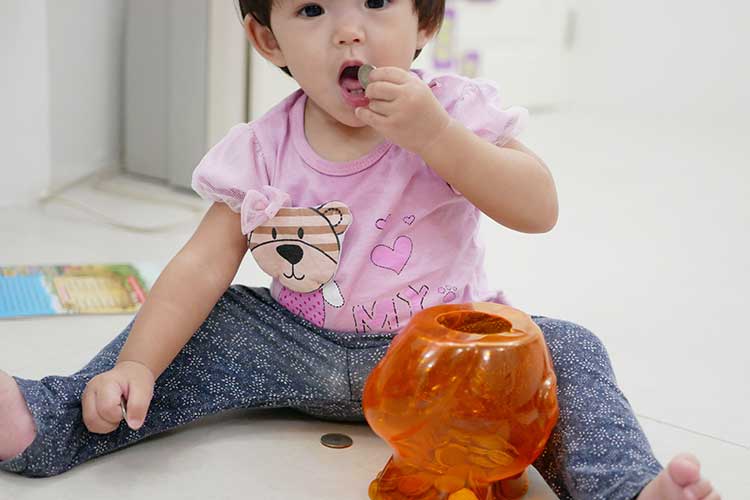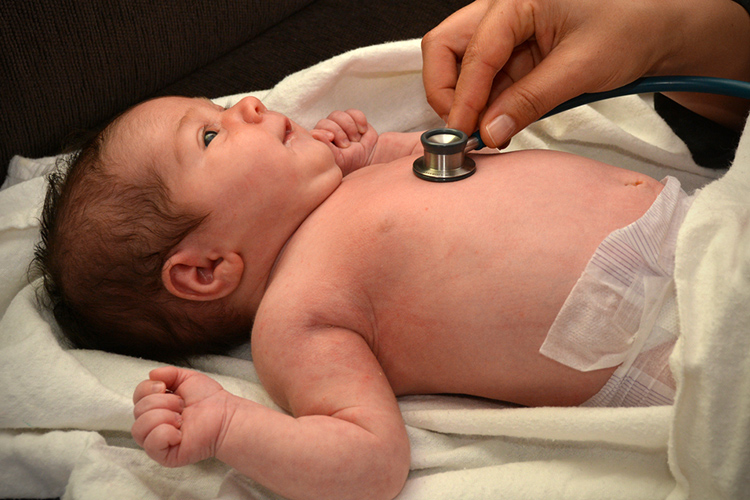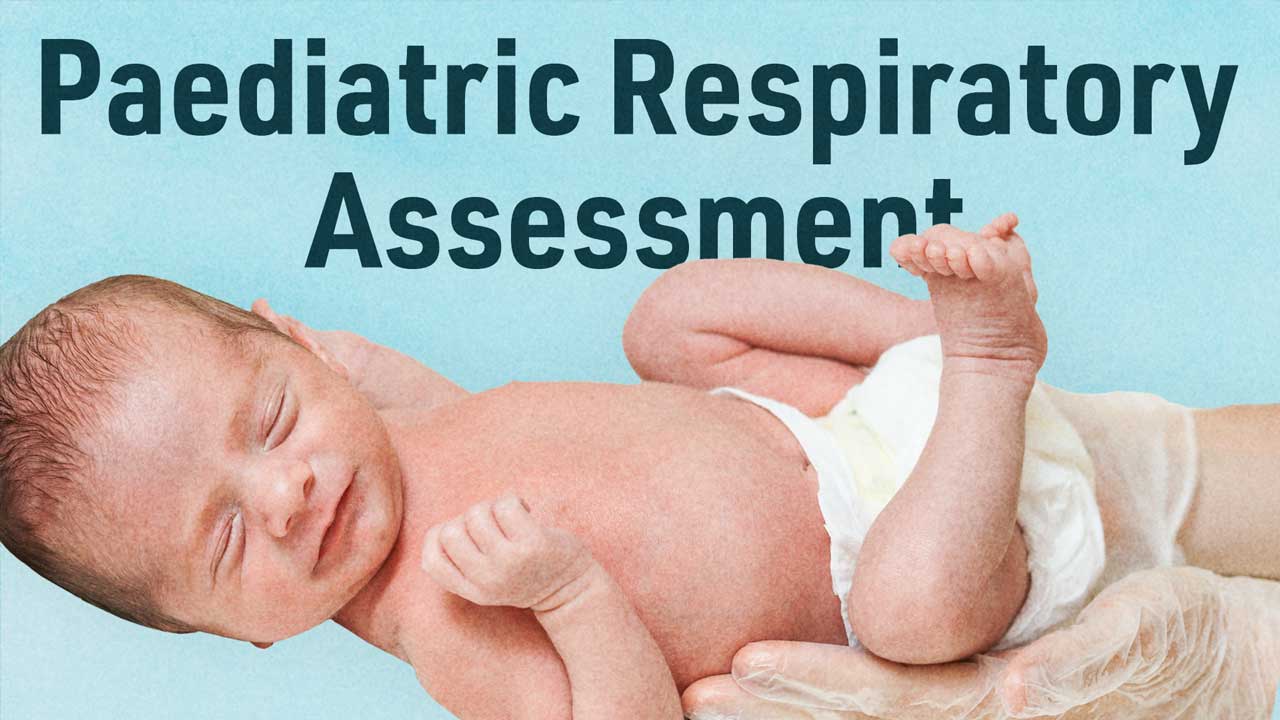In order to recognise, manage and treat respiratory conditions in children effectively, we need to be able to confidently assess a child’s respiratory rate, effort and efficacy.
In other words, we need to know what’s normal before we can assess what is abnormal.
Unlike adults, children breathe at different respirations per minute (rpm) according to age. It’s not uncommon for a newborn to have a respiratory rate of 60, whereas a 12-year-old can comfortably have a respiratory rate of 18 rpm.
The following table details the normal respiratory rate and heart rate for unwell children of different ages.
Paediatric Respiration and Heart Rate
Note: These are acceptable ranges for unwell children. They are not what would be expected normal ranges for healthy children.
| Age | Approximate weight (kg) | Respiration: breaths/min | Heart rate: beats/min |
|---|---|---|---|
| Term | 3.5 kg | 25-60 | 120-170 |
| 3 months | 6 kg | 25-60 | 115-170 |
| 6 months | 8 kg | 20-55 | 110-170 |
| 1 yrs | 10 kg | 20-45 | 105-150 |
| 2 yrs | 12 kg | 20-40 | 95-150 |
| 4 yrs | 15 kg | 17-30 | 80-150 |
| 6 yrs | 20 kg | 16-30 | 75-140 |
| 8 yrs | 25 kg | 16-30 | 70-130 |
| 10 yrs | 30 kg | 15-25 | 60-130 |
| 12 yrs | 40 kg | 15-25 | 65-120 |
| 14 yrs | 50 kg | 14-25 | 60-115 |
| 16 yrs | 60 kg | 14-25 | 60-115 |
| 17+ yrs | 65 kg | 14-25 | 60-115 |
(Adapted from RCHM 2023)
Why are Children Different to Adults?
Infants have larger heads and occiputs relative to their body size; therefore, the head is naturally flexed in the supine position. They also have large tongues in a small mouth and the trachea is shorter and more compliant. Due to these differences, a child’s airway is much easier to occlude than an adult’s (Saikia & Mahanta 2019).
A child’s upper and lower airways are also smaller than an adult’s and their lungs are not fully developed. They have soft, horizontally sloped ribs and poorly developed intercostals. Their chest walls are more compliant and children rely heavily on their diaphragm (Saikia & Mahanta 2019; RCHM n.d. a).
Overall, children’s smaller airways in addition to their other physiological differences mean they are more susceptible to airway obstruction, and their ability to breathe may be compromised by even minor injury or swelling (RCHM n.d. a).
Causes of Respiratory Distress in Children
The following are some common causes of respiratory distress in children:
- Upper respiratory infections such as croup and influenza
- Lower respiratory infections such as pneumonia and bronchiolitis
- Bacterial infections such as bacterial pneumonia or tuberculosis
- Allergies
- Asthma
- Tobacco smoke (second-hand smoke)
- Inhalation of foreign bodies
- Genetic conditions such as cystic fibrosis.
(HealthLink BC 2023)

Signs of Respiratory Distress in Children
- Increased respiratory rate
- Increased heart rate
- Colour changes (cyanosis or pallor)
- Noises such as stridor, wheezing or grunting
- Nasal flaring
- Retractions of the chest where it appears to sink in below the neck or breastbone with each breath
- Sweating
- Accessory muscle use
- Sternocleidomastoid contraction (head bobbing)
- Changes in consciousness state
- Body position changes, including tripod positioning or forward posturing.
(RCHM 2024)
Paediatric Respiratory Assessment
Early recognition of respiratory distress and deficit is vital to the successful management of sick children and the prevention of further deterioration or arrest. A systematic approach to assessment is crucial to managing respiratory distress (PCH 2023).
Generally, children in respiratory distress should have minimal handling. An assessment can usually be performed without touching the patient (RCHM 2024).
The ABCDE approach - Airway, Breathing, Circulation, Disability and Exposure - is a simple and effective method of assessment (PCH 2023).
When assessing the airway, you should consider the following:
- Is there airway patency?
- Are there any signs of airway obstruction?
- Is the patient making noises (e.g. stridor, snoring)?
- Does the patient have a hoarse voice?
- Is there any neck swelling or bruising?
- Is there a foreign body present?
(PCH 2023)
Drooling can indicate an obstruction. Patients with swelling such as epiglottitis will drool because they are unable or unwilling to swallow and may adopt the tripod position (Cathain & Gaffey 2022; Sicari & Zabbo 2023).
When assessing the breathing, you should consider the following:
- Effort
- What is the respiratory rate?
- Is there nasal flaring, grunt, tracheal tug or subcostal/intercostal recession?
- Efficacy
- Assess air entry, chest expansion and oxygen saturation.
- Effects
- Assess heart rate, skin colour and mental status.
(PCH 2023)

Always Remember
You need to be aware of what is normal before you can recognise what is abnormal. Establishing a baseline to compare progress or deterioration is helpful. When assessing a patient, use a systematic approach, such as ABCDE.
The goal of assessment is not to make a diagnosis but to identify a deteriorating child and respond to their symptoms to prevent arrest. Depending on the assessment findings, consider oxygen, suction and medication (PCH 2023).
Following the initial assessment (and resuscitation if required), a secondary structured assessment should be undertaken to identify any other key signs or symptoms (PCH 2023).
When assessing the airway, the life threat to identify is airway obstruction. This is a medical emergency and requires prompt management so that the patient can be oxygenated (RCHM n.d. b).
Test Your Knowledge
Question 1 of 3
True or false: The purpose of an initial assessment is to diagnose the patient.
Topics
Further your knowledge
 Free
Free Free
FreeReferences
- Cathain, EO & Gaffey, MM 2022, ‘Upper Airway Obstruction’, StatPearls, viewed 27 March 2025, https://www.ncbi.nlm.nih.gov/books/NBK564399/
- HealthLink BC 2023, Respiratory Problems, Age 11 and Younger, HealthLink BC, viewed 27 March 2025, https://www.healthlinkbc.ca/illnesses-conditions/lung-and-respiratory-conditions/respiratory-problems-age-11-and-younger
- Perth Children’s Hospital 2023, Serious illness, Government of Western Australia, viewed 27 March 2025, https://pch.health.wa.gov.au/For-health-professionals/Emergency-Department-Guidelines/Serious-illness
- The Royal Children's Hospital Melbourne 2020, Acceptable Ranges for Physiological Variables, RCHM, viewed 30 March 2023, https://www.rch.org.au/clinicalguide/guideline_index/Normal_Ranges_for_Physiological_Variables/
- The Royal Children's Hospital Melbourne 2024, Assessment of Severity of Respiratory Conditions, RCHM, viewed 27 March 2025, https://www.rch.org.au/clinicalguide/guideline_index/Assessment_of_severity_of_respiratory_conditions/
- The Royal Children's Hospital Melbourne n.d. a, How are Children Different, RCHM, viewed 27 March 20235, https://www.rch.org.au/trauma-service/manual/how-are-children-different/
- The Royal Children's Hospital Melbourne n.d. b, Primary and Secondary Survey, RCHM, viewed 27 March 2025, https://www.rch.org.au/trauma-service/manual/primary-and-secondary-survey/
- Saikia, D & Mahanta, B 2019, ‘Cardiovascular and Respiratory Physiology in Children’, Indian Journal of Anaesthesia, vol. 63 no. 9, viewed 27 March 2025, https://www.ncbi.nlm.nih.gov/pmc/articles/PMC6761775/
- Sicari, V & Zabbo, CP 2023, ‘Stridor in Children’, StatPearls, viewed 27 March 2025, https://www.ncbi.nlm.nih.gov/books/NBK525995/
 New
New 
